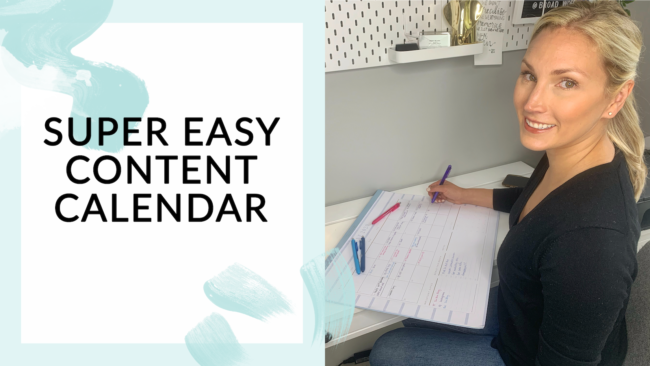My strategic content calendar template
A strategic content calendar is the key to being proactive in your marketing efforts. It ensures you get the most out of every piece of content you create, allows you to build sales funnels that work, and most importantly, frees up your posting time to actually engage and grow your business.
Below is my simple, easy-to-grow content calendar strategy. But before getting started, make sure you identify YOUR MAIN GOAL. It may vary from platform to platform, and you may have multiple KPIs to hit, but make sure your content is working in favour of your business goals. There’s no point spending your time creating beautiful, eloquent content that does diddly-squat for your business.
1. Stick to a strategy date
It doesn’t matter if you’re scheduling one week or one year of content at a time, you need to carve out a date that works for you (and your team) to strategize about the next round of content to align with your goals.
I usually work on a one-month calendar, so I carve out a Monday or Tuesday afternoon in the third week of each month to plan out the month ahead.
2. Note any important dates
Highlight any pending dates of importance. These could be massive holidays that you’ll have lots of content around, like Christmas or back to school. Or, smaller dates that align with your company’s MO, like Earth Day for a company with sustainability at its core.
While the new addition of silly dates like “donut day” or “margarita day” might be tempting to hit, if you aren’t a donut shop or restaurant these days will look like you’re forcing content. Be sure you aren’t forcing that content.
Remember: creating content is like a fart, if you have to force it it’s probably $#!*.
3. Identify opportunity for messaging and engagement
This seems similar to point two, but the difference is that we dig a little deeper into our business strategy. Mark down launches, days you’ll be closed or have extended hours, events you have coming up, or other announcements.
This is where you’ll weigh your content and see where you’ll make noise, how often, and over how many days.
4. Work backwards
You mapped out all your important dates in 3, now you work backwards. What do you want to say for each special date? How many times will you post about it? What creative and copy need to be compiled?
5. Fill the gaps with evergreen content
Once you can clearly see the flow of content, it’ll be easy to see where the gaps are. In your content strategy, you should have outlined how many days a week you’d like to post on each platform. Identify where you need more, and fill that with evergreen content.
Evergreen content is anything that isn’t seasonal and can be shared at any time. This is a great place to share brand stories, introduce the backstory and “WHY” of your brand, show the team and culture, or anything else that doesn’t date.
6. Create the content
Now that you’ve identified what needs to be created and when it needs to be done, you can either get cracking or delegate to team members responsible for different aspects of the work. If team members are working on the same content for different platforms (for example, one is doing the social and one is doing the blog) make sure they’re working to create a cohesive story.
7. Get every last drop out of your content
Beyond getting a cohesive story X-platform, make sure that you’re squeezing every last drop out of your content. Use the same images simply resized for different placements on social, EDMs, and blogs. Split blogs into digestible stats and soundbites that can be shared and saved on social. (Sorry, for the major alliteration there…) Share the same pieces of content multiple times depending on the platform. For example, breaking a blog down into 5-10 tweets is totally OK since tweets don’t live for very long.
Also, don’t forget about the past content you’ve created. Share older links when it makes sense and reshare stats that still apply. Each year on Father’s Day I share my What’s the Opposite of Daddy Issues blog because it still gets traction and I don’t have to spend the few hours writing and building out creative for it.
8. Use a scheduling tool
There are plenty of tools available, with prices ranging from free all the way up to thousands per month. Figure out what your needs are and find a program that helps you “set it and forget it.”
The biggest benefit of a scheduling tool is that you now don’t have to waste time posting each day, and instead you can engage with your audience, answer questions, and open the lead-gen floodgates.
***
Of course, the strategy is only one piece of the pie. I’d love to know what challenges you face when it comes to actually creating the content. What are your biggest hurdles? Is it imagery? Writing the copy? Getting your audience to take action? Let me know so I can cover it down the road.


